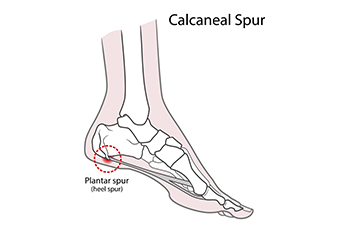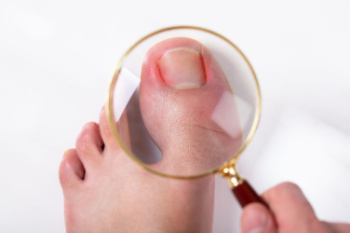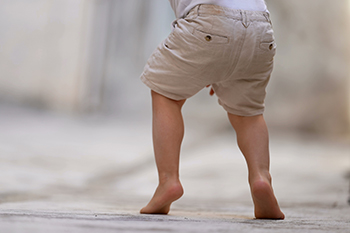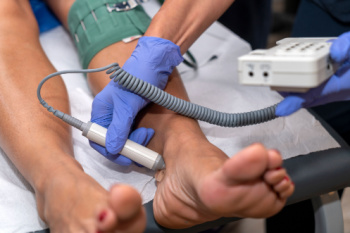June 2024
Types and Symptoms of Heel Spurs

Heel spurs are bony growths that develop on the heel bone, with the two main types being plantar and dorsal heel spurs. Plantar heel spurs form on the bottom of the heel and are often associated with plantar fasciitis, causing pain and inflammation where the plantar fascia connects to the heel bone. Dorsal heel spurs develop at the back of the heel, typically where the Achilles tendon attaches, leading to discomfort and swelling in the area. Common symptoms of heel spurs include sharp pain while standing up in the morning, tenderness, and difficulty walking or running. Diagnosis usually involves a physical examination and imaging tests like X-rays to confirm the presence of the bony growths. Heel spurs can be painful. If you have developed one, it is suggested that you consult a podiatrist sooner rather than later who can offer you correct relief and treatment options.
Heel spurs can be incredibly painful and sometimes may make you unable to participate in physical activities. To get medical care for your heel spurs, contact John Horlebein, DPM from Northern Cascades Foot & Ankle, LLC. Our doctor will do everything possible to treat your condition.
Heels Spurs
Heel spurs are formed by calcium deposits on the back of the foot where the heel is. This can also be caused by small fragments of bone breaking off one section of the foot, attaching onto the back of the foot. Heel spurs can also be bone growth on the back of the foot and may grow in the direction of the arch of the foot.
Older individuals usually suffer from heel spurs and pain sometimes intensifies with age. One of the main condition's spurs are related to is plantar fasciitis.
Pain
The pain associated with spurs is often because of weight placed on the feet. When someone is walking, their entire weight is concentrated on the feet. Bone spurs then have the tendency to affect other bones and tissues around the foot. As the pain continues, the feet will become tender and sensitive over time.
Treatments
There are many ways to treat heel spurs. If one is suffering from heel spurs in conjunction with pain, there are several methods for healing. Medication, surgery, and herbal care are some options.
If you have any questions feel free to contact our office located in Chelan, WA . We offer the latest in diagnostic and treatment technology to meet your needs.
Who Is at Risk for Ingrown Toenails?
 Ingrown toenails occur when the edge of a toenail grows into the surrounding skin, causing pain, swelling, and sometimes infection. Those at higher risk include individuals with curved or thick nails, those who trim their nails improperly, people who wear tight or ill-fitting shoes, and athletes or dancers who frequently stress their feet. Symptoms of ingrown toenails include redness, swelling, pain along the nail edges, and, in severe cases, pus or infection. Common causes are improper nail trimming, trauma to the toenail, and genetic predisposition. To prevent ingrown toenails, trim nails straight across, avoid cutting them too short, and wear shoes that provide adequate space for the toes. Relief for mild cases includes soaking the foot in warm water and keeping the foot clean. If you have severe symptoms of an ingrown toenail or it appears infected, it is strongly suggested that you schedule an appointment with a podiatrist who may prescribe antibiotics or possibly a minor surgical procedure.
Ingrown toenails occur when the edge of a toenail grows into the surrounding skin, causing pain, swelling, and sometimes infection. Those at higher risk include individuals with curved or thick nails, those who trim their nails improperly, people who wear tight or ill-fitting shoes, and athletes or dancers who frequently stress their feet. Symptoms of ingrown toenails include redness, swelling, pain along the nail edges, and, in severe cases, pus or infection. Common causes are improper nail trimming, trauma to the toenail, and genetic predisposition. To prevent ingrown toenails, trim nails straight across, avoid cutting them too short, and wear shoes that provide adequate space for the toes. Relief for mild cases includes soaking the foot in warm water and keeping the foot clean. If you have severe symptoms of an ingrown toenail or it appears infected, it is strongly suggested that you schedule an appointment with a podiatrist who may prescribe antibiotics or possibly a minor surgical procedure.
Ingrown toenails may initially present themselves as a minor discomfort, but they may progress into an infection in the skin without proper treatment. For more information about ingrown toenails, contact John Horlebein, DPM of Northern Cascades Foot & Ankle, LLC. Our doctor can provide the care you need to keep you pain-free and on your feet.
Ingrown Toenails
Ingrown toenails are caused when the corner or side of a toenail grows into the soft flesh surrounding it. They often result in redness, swelling, pain, and in some cases, infection. This condition typically affects the big toe and may recur if it is not treated properly.
Causes
- Improper toenail trimming
- Genetics
- Improper shoe fitting
- Injury from pedicures or nail picking
- Abnormal gait
- Poor hygiene
You are more likely to develop an ingrown toenail if you are obese, have diabetes, arthritis, or have any fungal infection in your nails. Additionally, people who have foot or toe deformities are at a higher risk of developing an ingrown toenail.
Symptoms
Some symptoms of ingrown toenails are redness, swelling, and pain. In rare cases, there may be a yellowish drainage coming from the nail.
Treatment
Ignoring an ingrown toenail can have serious complications. Infections of the nail border can progress to a deeper soft-tissue infection, which can then turn into a bone infection. You should always speak with your podiatrist if you suspect you have an ingrown toenail, especially if you have diabetes or poor circulation.
If you have any questions, please feel free to contact our office located in Chelan, WA . We offer the newest diagnostic and treatment technologies for all your foot care needs.
Managing Your Child's Toe Walking

Idiopathic toe walking, as it's called, occurs when a child continues to favor their toes for walking or running. This behavior, if left unchecked, can lead to tight calf muscles and decreased ankle movement. However, there are methods to address toe walking effectively. For children under six, treatment may involve calf stretches, Achilles tendon stretches, and sit-to-stand exercises. Older children may benefit from calf stretches, marching in place, and walking uphill. Other exercises include walking on uneven surfaces, heel walking, and squats. These aim to stretch and strengthen the calf muscles, while promoting a heel-to-toe walking pattern. It is important for parents to identify toe walking early to prevent potential complications, such as muscle tightness and weakness. If your child exhibits persistent toe walking beyond three years of age, it is suggested that you schedule an appointment with a podiatrist who can assess the extent of your child's condition, and provide recommendations tailored to their specific needs.
The health of a child’s feet is vital to their overall well-being. If you have any questions regarding foot health, contact John Horlebein, DPM of Northern Cascades Foot & Ankle, LLC. Our doctor can provide the care you need to keep you pain-free and on your feet.
Tips for Keeping Children's Feet Healthy
- Make sure their shoes fit properly
- Look for any signs of in-toeing or out-toeing
- Check to see if they have Clubfoot (condition that affects your child’s foot and ankle, twisting the heel and toes inward) which is one of the most common nonmajor birth defects.
- Lightly cover your baby’s feet (Tight covers may keep your baby from moving their feet freely, and could prevent normal development)
- Allow your toddler to go shoeless (Shoes can be restricting for a young child’s foot)
- Cut toenails straight across to avoid ingrown toenails
- Keep your child’s foot clean and dry
- Cover cuts and scrapes. Wash any scratches with soap and water and cover them with a bandage until they’ve healed.
If you have any questions, please feel free to contact our office located in Chelan, WA . We offer the newest diagnostic and treatment technologies for all your foot care needs.
Vascular Testing for Peripheral Artery Disease

Peripheral artery disease, or PAD, can significantly impact your quality of life by reducing blood flow to your legs and feet. Podiatrists play an important role in detecting and managing PAD through various non-invasive tests. Included are checking the pulse in your feet, using a handheld device to listen to the blood flow, and measuring blood pressure in your ankles and toes. Regular vascular assessments are essential, as early detection of PAD can prevent serious complications like sores or infections that heal poorly. If you experience leg pain while walking, numbness, or slow-healing wounds on your feet, it is important to visit a podiatrist because these symptoms are indicators of peripheral artery disease. A podiatrist can conduct these simple yet effective tests to determine if PAD is affecting you and recommend appropriate treatments or lifestyle changes. Ensuring that your podiatrist performs comprehensive vascular assessments can make a significant difference in managing your condition and improving your overall health. If you are experiencing symptoms of peripheral artery disease, it is suggested that you schedule an appointment with a podiatrist for testing and suggested treatment options.
Vascular testing plays an important part in diagnosing disease like peripheral artery disease. If you have symptoms of peripheral artery disease, or diabetes, consult with John Horlebein, DPM from Northern Cascades Foot & Ankle, LLC. Our doctor will assess your condition and provide you with quality foot and ankle treatment.
What Is Vascular Testing?
Vascular testing checks for how well blood circulation is in the veins and arteries. This is most often done to determine and treat a patient for peripheral artery disease (PAD), stroke, and aneurysms. Podiatrists utilize vascular testing when a patient has symptoms of PAD or if they believe they might. If a patient has diabetes, a podiatrist may determine a vascular test to be prudent to check for poor blood circulation.
How Is it Conducted?
Most forms of vascular testing are non-invasive. Podiatrists will first conduct a visual inspection for any wounds, discoloration, and any abnormal signs prior to a vascular test.
The most common tests include:
- Ankle-Brachial Index (ABI) examination
- Doppler examination
- Pedal pulses
These tests are safe, painless, and easy to do. Once finished, the podiatrist can then provide a diagnosis and the best course for treatment.
If you have any questions, please feel free to contact our office located in Chelan, WA . We offer the newest diagnostic and treatment technologies for all your foot care needs.







